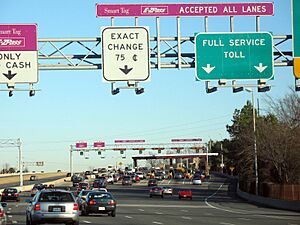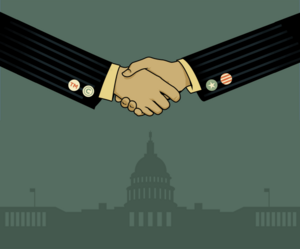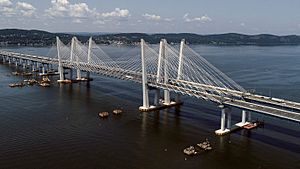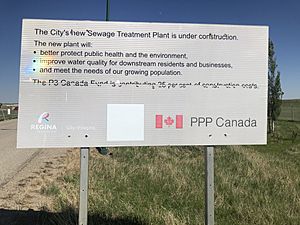Public–private partnership facts for kids
A public–private partnership (often called PPP or P3) is a long-term agreement between a government and a private company. Imagine the government needs a new school or a bridge. Instead of paying for everything upfront, they team up with a private business. This business helps pay for the project at the start. Later, the government or the people using the service (like drivers on a toll road) pay the private company back over many years.
PPPs are often used for big projects like building schools, hospitals, roads, and water systems. This idea of governments and private businesses working together has been around for a long time. However, the modern idea of PPPs became popular around the end of the 1900s. Governments saw them as a way to build new things without showing all the costs on their official budgets right away.
But PPPs can be a bit tricky. Some people worry that private companies might make too much money, or that the public doesn't get a good deal. Supporters say PPPs share risks and bring new ideas. Critics argue they can cost more and aren't always clear about how money is spent. It's often hard to tell if a PPP has truly saved money or been more efficient.
Contents
What is a PPP?

There isn't one perfect way to describe a PPP, because they can be very different. They are long-term agreements where a private company helps build and pay for public services or buildings. The private company also shares some of the risks involved.
For example, the OECD (a group of many countries) says a PPP is a long-term contract where a private partner builds and pays for public services using a big asset, and they share the risks.
Think of it this way: a private company might build a new road. They pay for it first. Then, drivers pay tolls to use the road, and some of that money goes to the private company over time. Or, the government might pay the company directly for providing the service.
Is it like privatization?
People often argue if PPPs are a type of privatization. Privatization is when something owned by the government is sold to a private company.
- Some say PPPs are not privatization because the government usually still owns the building or service. They are still in charge of making sure the public gets the service.
- Others say PPPs are a type of privatization. They see it as a step towards selling off public assets, even if it's not a full sale.
Because "privatization" can sound negative to some, people who support PPPs often say they are different. But those who don't like PPPs often call them "privatization in disguise."
How PPPs Started
Governments and private businesses have worked together for a very long time. In the early 1800s, for example, some people built roads or canals and then charged a fee to use them. This helped build important things like early roads and railways in the United States.
In the late 1900s and early 2000s, more and more governments around the world started using PPPs. This happened because governments had a lot of public debt (money they owed). They wanted private companies to help pay for new buildings and projects.
In 1992, the United Kingdom started a big program called the Private finance initiative (PFI) to encourage PPPs. At first, private companies weren't very interested, and public groups were against it. But the government pushed for it.
Later, in 1997, the new government in the UK expanded the PFI. They wanted to make sure these projects offered "value for money" and shared risks properly. They created a special group to help make PPPs the normal way to build public things. Other countries then copied this idea.
PPPs also became popular in developing countries. They promised new ways to pay for roads, hospitals, and other important projects, which could create jobs and help the economy grow. However, it was sometimes harder to make PPPs work in these countries because of different laws and less stable income from users.
How PPPs are Paid For
A key part of many PPPs is that private companies pay for most of the project at the beginning. How they do this can be different in each country. For example, in the UK, they might use bonds, while in Canada, they often use bank loans.
Sometimes, only the people who use the service pay for it. A good example is a toll road, like Highway 407 in Ontario, where drivers pay to use the road. In other cases, the private company builds the project, and then the government pays them regularly for the services they provide.
Special company for the project
Usually, a group of private companies forms a special company just for one project. This is called a special-purpose vehicle (SPV). This SPV is in charge of building, running, and taking care of the project for the agreed time.
For example, an SPV might build a hospital. The private companies in the SPV might include a construction company and a maintenance company. The SPV then leases the hospital to the government. The private company acts like a landlord, taking care of things like cleaning, while the hospital staff provides medical care.
This setup means the companies building the project also think about how it will be run later. This can be good, but sometimes it might lead to choices that save money on running costs but lower the quality of service.
Who invests?
Building public projects can be a steady and safe investment. So, big investors like pension funds, life insurance companies, and banks often put money into PPPs. They are looking for a reliable way to earn money over a long time.
Government's role
Governments also contribute to PPPs. They might give land or existing buildings. For projects that benefit everyone, like new roads, the government might give a one-time payment to help the project start. They might also offer tax breaks or promise to pay a certain amount each year to the private company.
Profits
Private companies in PPPs expect to make a profit. Sometimes, because they are the only company providing a service (like a toll road), they can charge high prices. This can lead to higher costs for people using the service or for taxpayers.
If a PPP involves new technology, there might be agreements to share profits. This means if the new technology makes a lot of money, some of that profit goes back to the public.
Why Use PPPs?
People have different reasons for supporting PPPs.
- Supporters say PPPs allow the government to use the skills and efficiency of private companies. They believe private businesses can build and run things better and faster than the government alone.
- Critics argue that PPPs are just a way to let private companies make money from public services.
Hiding costs
One reason PPPs became popular was that they could make it look like the government wasn't borrowing as much money. The private company does the borrowing, so the debt doesn't always show up on the government's official budget. This was seen as a way for governments to appear more responsible with money, even if the costs were just being paid later by users or future governments.
However, many experts have criticized this. They say it's just an accounting trick that hides the true cost of projects. Studies have shown that many PPP projects end up costing more than if the government had paid for them directly.
Project costs
Many studies have shown that PPPs often cost more than projects paid for directly by the government. Here's why:
- Higher borrowing costs: Governments can usually borrow money at lower interest rates than private companies. This is because governments can collect taxes, which makes them very reliable borrowers. So, private companies often pay more to borrow money for a project.
- Extra costs for contracts: PPP contracts are very complex. It takes a lot of time and many lawyers to agree on all the details. These "transaction costs" can add about 3% to the total bill.
- Private company profits: Private companies expect to make money from their investment. They will charge enough over the contract period to cover their costs and make a profit.
Sometimes, private companies find ways to make projects cheaper, but this can involve cutting corners or finding other ways to make money, like charging high fees for using school fields after hours. For example, a report in Ontario found that PPP projects cost 16% more than traditional public projects.
Value for money
To deal with concerns about high costs, supporters of PPPs started talking about "value for money." This means looking at the total cost of a PPP project compared to what a similar public project would cost.
However, it's hard to truly compare. The "value for money" calculations often make PPPs look better by putting a high value on the idea of "risk transfer" (the private company taking on risks). Critics say this can be confusing and makes it hard to see the real costs.
Also, the companies that do these "value for money" assessments often also advise on PPP projects, which can create a conflict of interest. This makes it hard to get a truly independent opinion. Many studies have found that PPPs often don't provide better value for money.
Transfer of risk
One of the main reasons given for PPPs is that they transfer risk from the government to the private company. This means if something goes wrong, like the project costing more than expected, the private company is supposed to take on that extra cost.
However, critics argue that PPPs don't always truly reduce risk for the public. The private company takes on the risk, but they charge the public for it. If the cost of this risk transfer is too high, the government ends up overpaying.
Reports have shown that private investors sometimes make huge profits from PPP deals, suggesting that governments are paying too much for this "risk transfer." Also, if a project runs into big problems, the risk often ends up back with the public sector anyway. There isn't much proof that private companies are always better at managing risks than the government.
Being Open and Accountable
A big criticism of PPPs is that they often lack accountability and transparency. This means it's hard to see how decisions are made and where all the money goes.
Many financial details of PPPs are kept secret because of "commercial confidentiality." This makes it hard for researchers and the public to understand if the projects are truly successful or if the public is getting a good deal. When documents are released, they are often heavily edited, with important information blacked out.
Studies in the U.S. have shown that cities often don't check up on their PPPs enough. They don't always track how well the services are being delivered, which makes it hard to know if the partnership is working.
Where PPPs are Used
PPPs are used in many different areas:
Water services
In the 1990s, many water services in different countries were privatized. But often, this didn't lead to better services or lower prices. Instead, water prices sometimes went up, making it hard for poor families to afford water. Because of this, some cities, like Paris, decided to take their water services back under public control.
However, in the 2010s, many cities in North America started using PPPs to update their old wastewater treatment plants.
Transportation

Transportation is another big area for PPPs. This includes:
- Airports
- Ports
- Roads (especially toll roads)
- Railways
- City transport like buses and trains
Famous transportation PPPs include the Confederation Bridge in Canada and parts of the London Underground in the UK.
Health services
For over 20 years, PPPs have been used to pay for health buildings like hospitals. Governments hoped PPPs would help solve bigger problems in health care. But some health PPPs have ended up costing much more than traditional public projects.
In a health PPP, a private company might design, build, and maintain a hospital. The government pays them for these services over many years. The private company takes on some risks but also aims to make a profit.
One problem with hospital PPPs in Canada is that it can create a split in who is in charge. The private company runs the building and maintenance, while the public sector provides the medical care. This can lead to strange situations where nurses can't ask maintenance staff to clean something without getting approval from private managers.
In the UK, many hospitals for the National Health Service were built using PPPs. These contracts often include services like cleaning and food. While they make up a small part of the NHS budget, the total payments are very large and will continue for many years.
Forestry sector
PPPs in the forest sector can involve governments, private companies, and non-profit groups working together to manage forests. Some groups promote these PPPs to help foreign companies use timber and other forest products from Third world countries. They claim this helps protect nature and use resources wisely, even though competition from foreign companies sometimes led to unsustainable practices in the first place.
Who Supports PPPs?
Besides national governments and financial companies, other groups also support PPPs:
PPP units
Many countries have special organizations called public–private partnership units. These groups help promote, set up, and check on PPPs in their area. They are often created when governments face criticism about how PPPs are being used. Many countries around the world now have these units.
Accounting firms
Big accounting firms like PricewaterhouseCoopers, Deloitte, Ernst & Young, and KPMG have been involved in PPPs from the start. They help governments create PPP rules, check on projects, and advise both private and public partners. Sometimes, these firms even invest in the projects they are checking, which can lead to questions about fairness. Critics say these firms might be more likely to recommend PPPs because they benefit from them.
International groups
The World Bank helps promote PPPs in countries where it works. The United Nations also encourages PPPs as a way to reach its goals, like providing affordable access to medicine in developing countries.
United States foreign policy
The U.S. government also promotes PPPs around the world to help achieve its foreign policy goals. Groups like USAID encourage private companies to invest in projects in other countries.
Types of PPPs
There are many different ways PPPs can be set up. Here are some common ones:
- Operation and maintenance contract (O & M): A private company runs a public building or service for a set time, but the government still owns it. This is a low-risk option for the private company.
- Build–finance (BF): The private company builds the project and pays for it during construction. Then, the government takes over.
- Build–operate–transfer (BOT): The private company designs, builds, runs, maintains, and pays for the project. After a certain number of years, the project is given back to the government.
- Build–own–operate–transfer (BOOT): Similar to BOT, but the private company owns the project during the contract period before giving it back to the government.
- Build–own–operate (BOO): The private company builds and owns the project forever. This is common for things like mobile phone networks.
- Build–lease–transfer (BLT): A private company builds a project and then leases it to the government. After the lease ends, ownership is transferred to the government.
- Design–build–finance–maintain (DBFM): The private company designs, builds, pays for, and maintains the project. The government then operates it.
- Design–build–finance–maintain–operate (DBFMO): The private company designs, builds, pays for, maintains, and operates the project. This is very common for toll roads.
- Concession: A government gives a private company the exclusive right to operate and invest in a public service (like water supply) for many years.
| Model | Identify Infrastructure Need | Propose solution | Project design | Project financing | Construction | Operation | Maintenance | Ownership | Concession? |
|---|---|---|---|---|---|---|---|---|---|
| Bid–build | Public sector | Private sector | Public sector | No | |||||
| Design–bid–build | Public sector | Private sector | Public sector | Private sector | Public sector | No | |||
| Design–build | Public sector | Private sector | Public sector | Private sector | Public sector | No | |||
| Design–build–finance | Public sector | Private sector | Public sector | No | |||||
| Design–build–finance–maintain | Public sector | Private sector | Public sector | Private sector | Public sector | No | |||
| Design–build–finance–operate | Public sector | Private sector | Public sector | No | |||||
| Design–build–finance–maintain–operate | Public sector | Private sector | Public sector | No | |||||
| Build–finance | Public sector | Private sector | Public sector | No | |||||
| Operation & maintenance contract | ? | Private sector | Public sector | No | |||||
| Build-operate-transfer | Public sector | Private sector | Public sector | Temporary | |||||
| Build–lease–transfer | Public sector | Private sector | Public sector | Private sector | Temporary | ||||
| Build–own–operate–transfer | Public sector | Private sector | Temporary | ||||||
| Build–own–operate | Public sector | Private sector | Yes | ||||||
| Market-led proposals | Private sector | Public sector | No | ||||||
Other Kinds of PPPs
While most PPPs are for big buildings or services, there are other types too:
Asset monetization
This is when a city leases out things that make money, like parking lots or public lights, to a private company. The city gets money right away, which they might use to pay off debts. In return, the private company gets to run these assets and collect the money from them.
Global public–private partnerships
These are partnerships between international groups (like the United Nations) and private companies. They work together on big global problems, like making sure people in developing countries can get important medicines.
Market-led proposals
Sometimes, a private company comes up with an idea for a PPP project and suggests it to the government. This is called a market-led proposal. It's different from when the government asks for proposals.
Public–private–community partnerships
These are PPPs that also include non-profit groups or community organizations. They are often used in developing countries to help local communities be more involved in planning and managing projects.
Social impact bonds
These are like special contracts where investors put money into social programs. If the program succeeds in reaching certain goals (like helping more people find jobs), the investors get paid back. If it doesn't, they might not get their money back.
See also
 In Spanish: Alianza público-privada para niños
In Spanish: Alianza público-privada para niños
- Privatization
- Government procurement
- Build–operate–transfer








